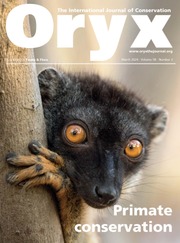Article contents
The rarest tortoise on earth
Published online by Cambridge University Press: 24 April 2009
Abstract
Core share and HTML view are not available for this content. However, as you have access to this content, a full PDF is available via the ‘Save PDF’ action button.
The Madagascan tortoise Geochelone yniphora, known locally as the ‘angonoka’, is found only near isolated patches of bamboo forest in the vicinity of Baly Bay in north-western Madagascar. As part of an Oxford University Expedition, and with some help from the Oryx 100% Fund, the author, together with Ian Scoones, Mike Guy and Gilbert Rakotoarisoa, has recently carried out a survey of the area. In this article, he discusses the conservation of this highly endangered animal.
- Type
- Research Article
- Information
- Copyright
- Copyright © Fauna and Flora International 1986
References
Bour, R. 1982. Contribution à la connaissance des tortues terrestres des Seychelles; définition du genre endémique et description d'une espèce nouvelle probablement originaire des îles granitiques et au borde de 1'extinction. Compr Rendu Hebd. Seanc. Acad. Sd., Paris, 295, 117–122.Google Scholar
Curl, D.A., Scoones, I.C., Guy, M.K. and Rakotoarisoa, G. 1985. The Madagascan tortoise Geochelone yniphora: current status and distribution. Biol. Conserv., 34, 35–54.Google Scholar
Groombridge, B. 1982. The IUCN Amphibia-Reptilia Red Data Book. Part I. Testudines, Crocodylia, Rhyncho-cephalia. IUCN, Gland, Switzerland.Google Scholar
IUCN/SSC Tortoise Specialist Group 1982. Revised Species Recovery Plan for the endangered Madagascan Angulated Tortoise (Geochelone = Asterochelys yniphora). Unpubl. proposal.Google Scholar
MacFarland, C.G., Villa, J. and Toro, B. 1974. The Galapagos giant tortoises (Geochelone elephantopus). I. Status of the surviving populations. Biol. Conserv. 6, 118–133.CrossRefGoogle Scholar
Siebenrock, R. 1903. Schildkröten von Madagaskar und Aldabra. Abhandl. Senckenb. Naturf. Gesellsch. 27, 241–258.Google Scholar
Vaillant, L. 1885. Sur une tortue terrestre d'espèce nouvelle, rapportée par M. Humblot au Museum d'Histoire naturelle. Bull. Soc. Phil. Paris, 440–441.Google Scholar
- 3
- Cited by


